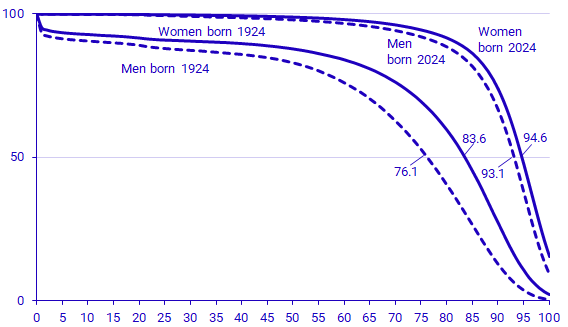Proportion survivors by sex and year of birth. Born 1924 and projection for born 2024

Comments
The proportion of the population that reaches older ages has increased markedly the last 100 years. This is illustrated in the diagram, which compares the mortality rates among those born in 1924 with the expected mortality rates among those born in 2024. Among those born in 1924, nearly 5 percent of women and nearly 7 percent of men died before their first birthday. This compares to 0.2 percent among those born in 2024. Half of the women born in 1924 were alive at age 83. Among men born in that same year, half of them were alive at age 76. The percent of that cohort to reach their 100th birthday in 2024 is estimated to about 2 percent among women and 0.5 percent among men.
The population projections indicate that half of the women born in 2024 will reach age 94, while half of the men in this cohort will reach age 93. Around 15 percent of the women and 9 percent of the men born in 2024 are expected to reach their 100th birthday.
The difference in mortality between the sexes was higher among those born in 1924 than it is expected to be among those born in 2024. The age at which half of the birth cohort remained alive was seven years higher for women than for men, among those born in 1924. This difference is expected to be around 1.5 years among those born in 2024.
When comparing two birth cohorts with a time space of 100 years differences in the proportion surviving to various ages becomes large. Life expectancy at birth was 74 years for women and 67 years for men, among those born in 1924. In the current projection, life expectancy at birth for those born in 2024 is estimated to be 92 years for women and 90 years for men. It is important to keep in mind that the calculations for those born in 2024 are projections that spans until 2130 for the oldest ages.
In the short term, this projection can be regarded as a population forecast. In the long term, the projection should be regarded as precisely a projection of the population in the case that current behaviour and trends continue in the future. Furthermore, an assumption is made that regulations that apply today will continue to apply throughout the projection period. Already in the short term, changes in society or in the world around us may mean that projection conditions will change.